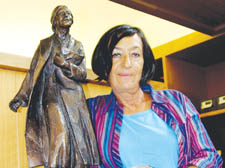|
|
 |
| |
 Professor Mary Davis with a maquette of Ian Walters' statue of Sylvia Pankhurst Professor Mary Davis with a maquette of Ian Walters' statue of Sylvia Pankhurst |
The ghost of Sylvia still rattles the Lords
A hundred years after she was first jailed, the suffragette Sylvia Pankhurst is at the centre of another political battle.
THE revolutionary socialist Sylvia Pankhurst got her first taste of the penal system in Holloway Women’s Prison in 1906.
The fortnight stretch – for “obstructive behaviour” following a demonstration where a group of suffragettes infiltrated Parliament and held an illegal meeting – was the 24-year-old’s introduction to the hunger strikes and forced feedings that would become her stock-in-trade.
One hundred years later – following great strides made in the women’s liberation movement as a result – the spectre of Sylvia Pankhurst has risen and is reacquainting itself with old foes.
Over the last five years a House of Lords select committee has repeatedly blocked a planning application – approved by Westminster Council and the House of Commons – from the Sylvia Pankhurst Memorial Association to raise a commemorative statue in Common Green, Parliament Square.
The chairman of the House of Lords Administration and Works Committee is Ivan Anthony Moore-Brabazon, the Third Baron Brabazon of Tara, but the other members’ identities are kept a closely guarded secret according to supporters.
Labour life peer Baroness Brenda Dean has raised the issue in the Lords on several occasions to no avail and this month the planning application expired and must be resubmitted.
But the death of the statue’s sculptor Ian Walters in July has breathed new life into the stuttering campaign.
The committee had questioned Walters’ ability, claiming in March 2004 that “the statue has no artistic stature”.
But this argument was made a nonsense of this year when it was agreed that a statue of Nelson Mandela, by Walters, should face Parliament from a plinth in Parliament Square.
This irony has not been lost on Sylvia’s supporters. Following a presentation of the bronze maquette by the Sylvia Pankhurst Memorial Committee in the Lords in June, many high-profile members of both Houses – including the former Speaker of the House of Commons Betty Boothroyd – have called for a suffragette-style protest by chaining themselves to the railings of Parliament Square.
Sylvia’s supporters – who include life peers such as author Ruth Rendell, the Attorney General Peter Goldsmith, and Professor Robert Winston – say their heroine should be immortalised, as her mother Emmeline and her older sister Christabel have been with a statue and a plaque in Victoria Tower Gardens outside the Commons.
The committee now claim that Sylvia “had no connection with the Lords which could justify the choice of such a prominent site”.
This is not completely true, although her connection with the Lords perhaps explains their five-year snub. Alongside her more “politically correct” campaigns for social justice, Sylvia also called for the overthrow of Parliament.
In her radical weekly, the Workers Dreadnought, with a 30,000 circulation, she wrote: “Though, perhaps, less open to personal corruption than the ambitious political hacks of the House of Commons, the Members of the House of Lords are, of course, even more surely lined up as one man against the emancipation of the proletariat.
“Even were it possible to democratise the machinery of Parliament, its inherently anti-Communist character would still remain. Under Communism we shall have no such machinery of legislation and coercion.”
Sylvia’s brand of revolutionary socialism is at odds with the Lords and lends weight to Professor Mary Davis, an expert on Sylvia Pankhurst and senior lecturer at London Metropolitan University’s centre for trade union studies, belief that the Lords’ snub is ideological.
She says: “We feel the site is particularly appropriate for a statue of Sylvia. Her commitment to improving the economic and social conditions of the poor, which she saw starkly in her work in the East End of London, emphasised the importance of sending MPs who were representative of workers into Parliament. She was an ardent anti-racist campaigner too – so universal suffrage was her overall objective – which, again, makes the site appropriate.
“The only conceivable reason for blocking the statue is political,” claims Prof Davis. “It is not surprising that Sylvia Pankhurst has been airbrushed out of history.
“Her brand of socialism did not accord with the mainstream. She wanted to mobilise a mass movement by joining separate spheres of the women’s movement with the labour movement. That is the problem – people in power can cope with individuals, collectivism they fear.
“The Lords refusing us means we have had to reapply for planning permission because planning applications expire after five years. It is quite ridiculous. The trouble is they just want statues of men on horseback.”
CLICK BELOW TO SERACH FOR ACCOMODATION
|
| |
|
 |
|